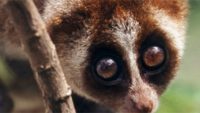A total solar eclipse is an amazing phenomenon, and can illustrate biblical teachings …read more Source: creation.com
By Joel Ebert The slow loris’ large eyes have a reflective layer to help them see in almost total darkness. …read more Source: AIG Daily
A pair of new studies found that some dinosaurs, and possibly some marine reptiles, laid squishy eggs. One study discovered that many dinosaurs, like turtles and snakes, laid soft leather-like eggs—not hard-shelled eggs like most birds.1 A second study found a massive leathery egg about the size of a football in Cretaceous sediments in Antarctica.2 However, they think it was from a marine reptile and not a dinosaur.More… …read more Source: icr.org
Is it a safe and healthy practice to build using lots of timber, or not? Some French and Norwegian policy-makers say yes, while some British policy-makers disagree.1 The French support their enthusiasm for constructing buildings with lots of wood, assuming that doing so somehow helps save the planet from manmade global warming. They argue that “timber construction … [helps] trees lock up climate-heating carb… More… …read more Source: icr.org
By Ken Ham For hundreds of years, we’ve classified organisms according to the system developed by Carl Linnaeus. Organisms fall into various kingdoms, phyla, classes, orders, families, genera, and species. It’s a time-honored method of categorizing what God has made. But some scientists are trying to change this. As you can see, this new system of classification is entirely based on the evolutionary tree of life and the idea that all life had a common ancestor. As one popular science article begins, “Move over, Linnaeus: There’s a new way of naming organisms.” This new system is known as the PhyloCode [More]
By Ken Ham Our head of horticulture at the Ark Encounter told my wife, Mally, and me that the large firecracker plant (Vermillionaire Cuphea) was the best plant to attract hummingbirds, so my wife put one on our deck. It didn’t take long. While I was sitting on the deck, a beautiful female ruby-throated hummingbird—the only breeding hummingbird species in eastern North America—came up to the plant and I was able to snap a couple of photos with my smartphone. Worthy are you, our Lord and God, to receive glory and honor and power, for you created …read more Source: [More]
Once again, a scientific study shows how “farmed” or ranched creatures live better if their domesticated context resembles their natural habitat.1 According to a recent study published in Aquaculture Reports, confined fish at Brazilian farms raising Nile tilapia (Oreochromis niloticus), fared better if they had an assortment of shelter-like structures and/or artificial plants.2,3 As a fish that … More… …read more Source: icr.org
As June transitions into July, it’s time for fruit harvesting—including apples, peaches, pears, and cherries. Notice how fruit phenology (seasonal life cycles) is linked to the timing of agricultural harvesting. As peach thinning continues, the first fruits are ready to be harvested; sweet cherries in mid-June and sour cherries in late June or early July. July also brings ripe plums, t… More… …read more Source: icr.org
A complex metabolic process called Chaperone-Mediated-Autophagy (CMA) was thought to be a recent evolutionary development in land vertebrates as it was only previously documented in mammals and birds. Now it has been found to be fully operational in fish—once again demonstrating that a lack of human knowledge is not evidence for evolution.1 Autophagy is an amazingly complex and ingenious process in which cells are … More… …read more Source: icr.org
A recent study published in the journal Frontiers in Earth Science indicates that North America was once home to large populations of camelids (creatures such as camels, llamas, and alpacas) and antelope-like animals.1,2 Once again, we should be amazed with how God has equipped the camel—and its cousins—to dwell and thrive in many parts of the earth.3 More… …read more Source: icr.org
No! That was early during Noah’s Flood and continents still existed …read more Source: creation.com
Folded, bent and deformed rock layers across the globe testify to catastrophe on an unimaginable scale. …read more Source: creation.com
The growth rings in Paleozoic corals are often used to support the idea that the earth is very old, but the argument was flawed from the beginning. …read more Source: creation.com
Have Trinidadian guppies learned evasive maneuvers from Spanish bullfighters? Recent research published in the journal Current Biology1 reports how gutsy guppies confront a regular predator, the voracious pike cichlids, like a matador. They attract the attacker to a location that can be dodged from. Then, at the last instant, the guppy pivots to safety.1-3 Trinidadia… More… …read more Source: icr.org
In order for the bizarre theory of evolution to be validated, evolutionists must show how inorganic non-life organized itself into carbon-based (organic) life. They also must show how major transitions in animals occurred, including how fish became the first tetrapods. This means fish fins would need to slowly turn into feet and legs. As one secular journal said, “The evolution of fishes into tetrapods—four-legged vertebrates of which… More… …read more Source: icr.org
Did octopus fossil ink really survive millions of years? …read more Source: creation.com
The social behavior of ants continues to amaze scientists with its complexity and efficiency of organization and design. In a new study, scientists have shown how ant communities foraging for food and other resources embody a complex system of behavior and path marking that creates an optimized search with minimal waste of energy and time.1 The information gleaned from this study was then applied to the design of computer search algori… More… …read more Source: icr.org
By Ken Ham When we think rainforests, we think tropical, sunshine (and lots of it), and frequent rains. We don’t think of frigid winds, bone-chilling temperatures, and icy seawaters. But that’s where the remains of a fossil rainforest were found—on the continent known for penguins instead of tropical parrots: Antarctica! A new study found tropical fossils, similar to the current flora in New Zealand’s South Island, in Cretaceous layers. Now, this isn’t the first time the remains of seemingly out-of-place organisms have been found on the southernmost continent. But a new study found tropical fossils, similar to the current flora [More]
By Heather Brinson Bruce Some questions don’t ever seem to get resolved. What about the age-old question: “What came first, the chicken or the egg”? …read more Source: AIG Daily
Why billions of years is an even bigger issue than evolution. …read more Source: creation.com
For a generation of millions (maybe billions) of North American jumping bugs called cicadas—often mislabeled in America as locusts—life changes dramatically after 17 years, yet for others the special timeframe is 13 years.1,2 And for many such periodical cicadas, reports Kirsten Geddes, it’s about that time. Cicadas, those little bugs that make … More… …read more Source: icr.org
Recently, after audio-recording underwater in Greenland’s fjords, two geoscientists published research on vocalizations made by narwhals. The sounds included shrill whistle tones, repetitive clicks, knocking sounds, buzzing noises, and even some tonal pulses inaudible to human ears.1,2 Complicating the situation, narwhals routinely summer near calving icebergs, so their natural surroundings are often noisy. More… …read more Source: icr.org
Evolution is often claimed to explain something and its opposite, so it certainly should not be called science, rather an unfalsifiable ideology! …read more Source: creation.com
Where are the small craters expected by the ‘billions of years’ framework on Pluto’s moon Charon? Read More
An amazing abundance of life can be found in the strangest places—such as the backs of turtles. It was previously known that an array of life was present on the backs of loggerhead sea turtles, and new research shows that it’s more abundant and diverse than scientists ever realized.1 An international group of researchers, headed up by Florida State University scientists, discovered more than double the total nu… More… …read more Source: icr.org
European dippers are making the news lately, including science news in Wales.1-3 These riparian habitat birds are indicators4 of freshwater stream quality, as noted below. Scientists study them to learn how badly freshwater streams are polluted—such as by non-biodegradable (non-decaying, indigestible) plastic waste products.2,3 Birds living on … More… …read more Source: icr.org












































